Uncategorized
6 spectacular synagogues from a new book on Manhattan’s houses of worship
(New York Jewish Week) – In the mid 1990s, New York-based photographer Michael Horowitz wandered into the Eldridge Street Synagogue, a historic synagogue that is now dedicated to preserving the history of the Jewish Lower East Side.
At the time, the synagogue was undergoing a massive, $20 million, 20-year restoration. Horowitz, who is Jewish but said he is “not religious,” was moved by the resilience and perseverance of the congregation. Even more so, he was attracted to the building’s architecture and the dedication the community poured into preserving it.
Horowitz returned to Eldridge Street over the years to document each stage of the building’s renovations. It was in 2013, while looking for a new photography project, that Horowitz realized his impulse to document Eldridge Street could be translated to houses of worship throughout the city. He spent the next decade photographing Manhattan’s churches and synagogues — 95 of which are spotlighted in his new book “Divine New York: Inside the Historic Churches and Synagogues of Manhattan.”
Together, these buildings tell a fascinating New York story of immigration, architecture, faith and progress. “I wanted to open the doors to the public,” Horowitz, 71, told the New York Jewish Week. “I wanted to show everyone what was going on inside these buildings and show them how beautiful they are.”
He worked his way from Lower Manhattan through Harlem to some of the most notable houses of worship in the borough — from St. Patrick’s Cathedral in Midtown to the First Roumanian American Congregation, a now demolished Orthodox synagogue on the Lower East Side once known as “The Cantor’s Carnegie Hall.” Since beginning the project, a dozen of the buildings Horowitz photographed have been demolished, he said.
“Everyone should take the time and view them — even if you’re not religious,” added Horowitz, who has been interested in ecclesiastical architecture since he was a student at Queens College. “Then people will get an idea of what makes that specific group of people interesting and beautiful regardless of the dogma.”
According to writer Liz Hartman, who wrote the text to accompany Horowitz’s photos, these buildings tell the story of New York itself: When immigrant groups first came to the city with few resources, the structures were small and unassuming. Synagogues were built to serve one particular community — the Lower East Side’s Bialystoker Synagogue, for example, whose congregants were new immigrants from Bialystok, Poland. As the Jewish community began to prosper — and as immigrants began to arrive from all over Europe — synagogues became grander, more confident and diverse in membership.
“New York is the story of immigration, and the churches and synagogues are the story of immigration as well,” Hartman said. “Immigrants — New Yorkers — projected themselves through their houses of worship, and in a way that’s what made the city work. I hope that we can look at this project and see a story of immigrants — and see that we can support this with different groups going forward.”
Eleven of the houses of worship featured in “Divine New York” are synagogues. The New York Jewish Week tasked Horowitz and Hartman with selecting the most historically or architecturally significant synagogues of the bunch —no easy task because every house of worship in the book is a historic and notable one. Keep reading to see their selections and to learn more about these important Jewish sites.
Eldridge Street Synagogue (12 Eldridge St.)
A prominent stained glass window at Eldridge Street was destroyed in a 1938 hurricane — it wasn’t replaced until 2010, with a design from artist Kiki Smith (right). (Michael Horowitz)
This historic Lower East Side synagogue, dedicated in 1887, was the first synagogue building in New York erected specifically as a Jewish house of worship. “Right from the start, it distinguished itself from other synagogues by welcoming Jews from all over Eastern Europe while other congregations were defined by the towns or cities from which they came,” Hartman writes in the book. “It was also economically diverse; migrants right off the boat, peddlers, sweatshop workers, bankers, and entertainers were among its members.” The synagogue was also Orthodox at a time when New York’s grandest synagogues were being built by Reform congregations.
Eldridge Street Synagogue as seen from the balcony. (Michael Horowitz)
For decades, the synagogue thrived as Jewish immigrants filled the Lower East Side. However, by 1940, facing a dwindling membership, the congregation could no longer maintain the main sanctuary and closed it down. By 1970, the building was in danger of collapse and demolition. Students, journalists and historians teamed up to save the synagogue; the restoration began in 1986 and continued to 2007. Today, the building is known as the Eldridge Street Synagogue and Museum, which features exhibits, history and lectures on immigrant life in New York.
The Bialystoker Synagogue (7-11 Bialystoker Pl.)
The Bialystoker Synagogue is found in a Lower East Side building with an unassuming exterior, a holdover from the Methodist Church that was once there. (Michael Horowitz)
Founded on the Lower East Side in 1865, the Bialystoker Synagogue made its home in 1826 church building, purchased from a Methodist congregation, made with schist from Manhattan bedrock. The congregation maintained the austere exterior — though the interior was updated dramatically and boasts a grand ark and floor-to-ceiling stained glass windows. Curiously, an image of a lobster is featured on the elaborately painted ceiling murals — with little explanation for how the non-kosher crustacean might fit into the synagogue’s mission or Jewish identity. One hint is that the panel marks the Hebrew month of Tammuz, which corresponds with the astrological sign of Cancer, the crab. “It was bought from the Methodist Mariner’s Church, and there were a lot of fishermen that belonged to that church,” Horowitz told the New York Jewish Week. Or perhaps a kosher-keeping muralist didn’t know the difference between a lobster and a crab.
An image of a lobster is on the ceiling of the synagogue, in a mural marking the Hebrew month of Tammuz. (Michael Horowitz)
The synagogue, built in a traditional Orthodox style, has a balcony for women worshippers. In one corner of the balcony, a hidden door leads to an attic, which Hartman writes was allegedly a stop on the Underground Railroad.
The synagogue underwent a renovation in 1988 and is still an active traditional Orthodox congregation.
Central Synagogue (652 Lexington Ave.)
Central Synagogue moved into its Lexington Avenue location in 1872. While most congregations face east, towards Jerusalem, Central faces west. Hartman explains that the real estate was “too good to pass up,” and the congregation decided to have an entrance on Lexington. (Michael Horowitz)
Completed in 1872, the building that houses the renowned Reform congregation in Midtown East seats nearly 1,500 people — a fraction of the congregation’s approximately 2,600 members. That’s a long way from the original 18 members from Bohemia, a region of the present-day Czech Republic, who started the congregation in 1846 in a remodeled church in the East Village.
Central Synagogue was built around the same time and in the same neighborhood as the Episcopal St. Thomas Cathedral and the Catholic St. Patrick’s Cathedral — some of New York’s grandest churches, which are also featured in the book. “Each of the groups were saying, ‘We’re here and we’re proud and we have prosperity.’ They were showing off, but in a really beautiful way,” Hartman said. “For Central, it was very much a message of assimilation. They were as interested in liberty, inclusion and reform as they were in Jewish ritual.”
Congregation Shearith Israel (8 West 70th St.)
Congregation Shearith Israel, also known as the Spanish and Portuguese Synagogue, was the only synagogue in New York for nearly a century and a half. The congregation moved several times before finding a permanent home on the Upper West Side. (Michael Horowitz)
Congregation Shearith Israel, also known as the Spanish and Portuguese Synagogue, was the first Jewish congregation in the United States, made up of Sephardic Jews who had arrived in New York in 1654 via Recife, Brazil. The congregation was the only Jewish one in New York for a century and a half before a faction of Ashkenazi members grew big enough to split off and form B’nai Jeshurun in 1825. While the congregation was housed in several different buildings throughout its history, it has been in its current home on the Upper West Side since 1896.
Temple Emanu-El (1 East 65th St.)
Temple Emanu-El was named one of eight “religious” wonders in the United States by CNN, writes Hartman. (Michael Horowitz)
Founded by a small group of German Jews in 1845, Temple Emanu-El has become one of the grandest and more well-known synagogues in New York, boasting prominent members like ex-mayors Ed Koch and Mike Bloomberg, as well as hundreds of other influential Manhattanites.
Considered one of the leading synagogues in the Reform movement, Emanu-El made waves throughout the 19th century for translating all-Hebrew services into German, then English, as well as for installing an organ and for abandoning the mechitzah, the traditional divider between men and women during prayer. After several spots downtown, the congregation moved into its current building on 5th Avenue — the former site of John Jacob Astor’s mansion — in 1927. It can hold 2,500 people, making it one of the largest synagogues in the world.
Park East Synagogue (163 East 67th St.)
The architects Schneider and Herter “took a no-holds-barred approach to the elaborate Byzantine-Moorish design of the synagogue,” writes Hartman of the arches, colors, stained glass and ark at Park East. (Michael Horowitz)
Built in 1890 by brothers Jonas and Samuel Ephraim in honor of their late father, Zichron Ephraim, this Orthodox synagogue has elaborate and eclectic arches, cupolas and stained glass throughout its design, reflecting its prominence in the New York Jewish community. “The design of the synagogue is anything but subtle and so, too, is its spiritual leader for more than 50 years, Rabbi Arthur Schneier, who is outspoken in his advocacy of religious freedom, human rights, and mutual respect,” writes Hartman.
It was Schneier who invited Pope Benedict XVI to Park East in 2008, marking the first ever papal visit to a synagogue in the United States. Schneier, who is currently searching for a successor, was conferred a papal knighthood for interfaith effort for religious freedom. For many decades, Park East was a haven for Jews who immigrated from the Soviet Union.
—
The post 6 spectacular synagogues from a new book on Manhattan’s houses of worship appeared first on Jewish Telegraphic Agency.
Uncategorized
The 7 political stories Jews will be watching in 2026
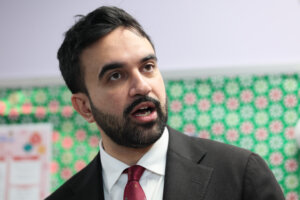
This year brought sweeping change in national politics, in the U.S.-Israel relationship and in New York, the city with the largest Jewish population.
At the Forward, we closely tracked the transition to President Trump’s second term and profiled his cabinet selections and controversial nominees and appointees who trafficked in antisemitism or had ties to white nationalists and expressed admiration for Nazis. We covered the president’s crackdown on the pro-Palestinian campus protests that defined 2024 and the weaponization of antisemitism that led to multimillion dollar settlements with Ivy League universities, including Columbia and Cornell.
We provided exclusive, on-the-ground reporting on the battle for the Jewish vote in the competitive New York City mayoral race. We conducted the first Jewish-media interview with Zohran Mamdani as his campaign began gaining traction, even while he was still polling a distant second in the Democratic primary. We also had inside access to the outgoing Eric Adams administration and its effort to counter rising antisemitism, and had the only local reporter accompanying Adams on his farewell trip to Israel.
Here are the seven political stories we’ll be watching most closely in 2026 that will shape American politics and the Jewish community in the U.S. and abroad.
Zohran Mamdani’s New York City
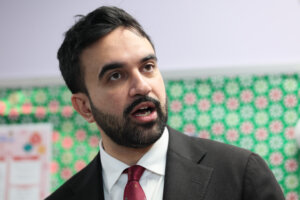
Mamdani will be sworn into office at midnight on Jan. 1, 2026 as the city’s first Muslim mayor. The swearing-in will be followed by an inauguration ceremony that day at a yet-undisclosed location.
He will immediately face a series of tests on the promises and priorities that carried him through the historic campaign at a moment when the city’s Jewish community remains divided over his stance on Israel. Mamdani’s mixed response to the protest outside the Park East Synagogue, which featured anti-Israel and antisemitic slogans last month, is likely to come under fresh scrutiny as his term begins. Mamdani has remained mum on whether he’d support new legislation that would create a buffer zone outside houses of worship to protect congregants from targeted protests.
Mamdani will also have to decide whether to rescind a recent executive order by Adams barring city agencies from participating in Boycott, Divestment and Sanctions efforts. He will also determine the fate of the recently-created mayor’s office to combat antisemitism, which has pursued a measure adopting the controversial International Holocaust Remembrance Alliance definition of antisemitism, which considers most forms of anti-Zionism as antisemitic. And he will need to decide whether to continue the New York City–Israel Economic Council, an initiative to strengthen economic ties with the Jewish state.
He will file top City Hall and government positions, including the potential appointments of his senior Jewish advisers.
Last month, Mamdani announced he’ll reappoint Jessica Tisch, the Jewish NYC police commissioner, as head of the police department he promised to reform.
The battle for the Jewish vote in the governor’s race
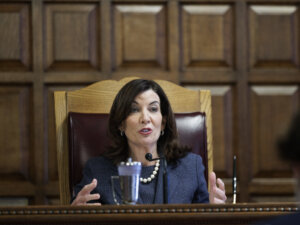
Mamdani’s first months in office and his legislative agenda will also shape the New York governor’s race.
Gov. Kathy Hochul, running for reelection for another full term, endorsed Mamdani in the general election after remaining neutral during the primary. She has signaled reservations about several key Mamdani priorities, like universal free buses, which will need the state’s approval, and has also distanced herself from Mamdani on Israel.
Hochul’s embrace of Mamdani could bolster her standing in the Democratic primary, where she faces a left-wing challenge from her lieutenant governor, Antonio Delgado, who is married to a Jewish woman.
But it could also complicate her outreach to Jewish voters in the general election. Bruce Blakeman, the first Jewish executive of Nassau County on Long Island, and Rep. Elise Stefanik, an upstate congresswoman who has made the fight against antisemitism on college campuses central to her congressional brand, are competing in a GOP primary to challenge Hochul. In 2022, former Rep. Lee Zeldin came within five percentage points of winning the governor’s race, powered by strong Jewish support.
Who will win Jerry Nadler’s seat?

After serving 17 terms in Congress, Rep. Jerry Nadler, co-chair of the Congressional Jewish Caucus, is set to retire to pave the way for generational change, a race that will be closely watched locally and across the nation.
The Manhattan district has one of the largest Jewish electorates in the nation. Jews in the 12th Congressional District account for about 30% of the vote in the Democratic primary. Nadler has, in recent years, campaigned on the need to preserve New York City’s Jewish representation in Congress.
The Jewish candidates vying for the seat include Micah Lasher, Jack Schlossberg, and Cameron Kasky. Assemblymember Alex Bores, whose wife, Darya Moldavskaya, is Jewish, and Councilmember Erik Bottcher are also considered viable candidates. Lasher, a protege of Nadler, has the longtime Jewish congressman’s support. Schlossberg, the grandson of former President John F. Kennedy, has made funding for security measures at synagogues and Jewish institutions a central pillar of his campaign.
Other New York congressional races

There are a few other House races in New York where pro-Israel incumbents are facing challenges from the left. Those primary contests are a crucial test of whether support for Israel and an alliance with the American Israel Public Affairs Committee has become a political liability.
Rep. Dan Goldman, the Jewish congressman representing the north of Brooklyn and the Lower Manhattan district since 2023, is being challenged in the primary by Brad Lander, the outgoing city comptroller and former mayoral candidate, who has the backing of Mamdani and other progressive firebrands. For his campaign, Lander hired Morris Katz, a Jewish strategist and ad maker who was behind Mamdani’s successful working-class appeal and inspiring TV commercials. Katz produced Lander’s Mr. Rogers-themed launch video.
Lander, who is also Jewish, has become more vocal about Palestinian rights in recent years. He supported Ben & Jerry’s decision to end sales in the occupied West Bank in 2021 and has regularly attended a weekly rally against the Israeli government’s handling of the war in Gaza. Recently, he acknowledged that he divested from Israel Bonds in 2023, ending the city’s decades-long practice of investing millions in Israeli government debt securities. In his candidacy announcement, Lander slammed Goldman’s support for the war in Gaza and accused him of “doing AIPAC’s bidding,” though the incumbent had early on called for humanitarian pauses and criticized Israeli Prime Minister Benjamin Netanyahu’s leadership.
Rep. Ritchie Torres, a three-term pro-Israel progressive from the Bronx, is facing three primary challengers, a crowded field that could ultimately make it easier for him to win reelection. Michael Blake, a former state legislator who ran for mayor in the Democratic primary and later endorsed Mamdani, is making attacks on AIPAC central to his campaign, and Dalourny Nemorin, an organizer for the Democratic Socialists of America’s local chapter, is testing the momentum behind newcomer and socialist candidates. Assemblywoman Amanda Septimo, who joined an AIPAC-sponsored trip to Israel in 2016 and visited Israel again following the Oct. 7, 2023 Hamas attacks, also announced her candidacy. Septimo is considered a member of Mamdani’s inner circle.
Rep. Michael Lawler, a Republican who has been a strong pro-Israel voice since his election in 2022, is expected to face the winner of an eight-person Democratic primary in a tough election cycle for Republicans. Lawler has the support of the growing Hasidic population in Rockland County. The leading candidates in the Democratic primary are Rockland County Legislator Beth Davidson, who is Jewish, and Army veteran Cait Conley.
Michigan Senate race a test for Democrats’ positions on Israel

The Michigan Senate race is shaping up to be one of the clearest tests of the Democratic coalition and of how the party navigates Israel.
The leading candidates in the Democratic primary are Abdul El-Sayed, an Egyptian-American who is seeking to channel the energy of the 2024 Uncommitted movement and build on Mamdani’s surprise success in New York, and Rep. Haley Stevens, a pro-Israel Democrat who defeated progressive Jewish Rep. Andy Levin in 2022 with significant help from AIPAC.
The outcome of the contest will offer an early read on whether the left’s anti-establishment momentum can break through in a battleground state, and how much pro-Israel groups retain their influence in Democratic primaries.
The Jewish governors running for reelection
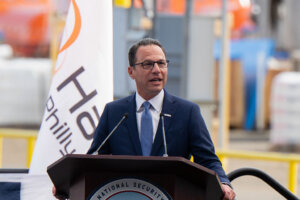
Pennsylvania Gov. Josh Shapiro and Illinois Gov. JB Pritzker are widely expected to win reelection. Their margins, messages and national profile will position both as major figures in the early mix for the 2028 presidential race. Each is navigating the same balancing act that will challenge Democrats with national ambitions: trying to appeal to a base that is growing more critical of Israel while still keeping the trust of Jewish voters and pro-Israel allies.
Shapiro, who was viewed as a potential first Jewish president in 2024, remains on the narrow path he has carved out for himself. He highlights his Jewish identity, support for Israel and bipartisan appeal in all of his public appearances.
Pritzker, who governs a state with one of the largest Palestinian-American populations in the country, has become one of the most prominent voices of resistance to President Donald Trump. He has repeatedly invoked Nazi Germany in criticizing the administration’s policies and endorsed a Senate push to block U.S. arms sales to Israel to pressure Prime Minister Benjamin Netanyahu on the Israeli-Palestinian conflict.
Israeli elections
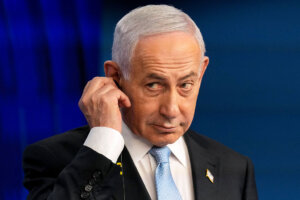
Israeli Prime Minister Benjamin Netanyahu will continue to be in the headlines in America. He is expected to spend New Year’s Eve in the United States after yet another meeting with Trump at the Mar-a-Lago resort — the sixth meeting this year — underscoring the unusually close alignment between the two leaders.
Netanyahu is better known to Americans than most world leaders. He is now Israel’s longest-tenured prime minister, having served for more than 18 years as the country’s leader. He grew up in Philadelphia in the early 1960s, attended college and graduate school in Boston, served as Israel’s ambassador to the U.N. in the mid-1980s, and has delivered four speeches to a joint session of Congress.
Following three tumultuous years, Israeli voters are poised to head back to the ballot box sometime in 2026 — depending on how long the coalition government holds onto power amid legislative challenges — for what will effectively be another referendum on Netanyahu’s leadership. A January 2024 poll found that only 15% of Israelis, including 36% of those who had previously voted for his Likud Party, wanted to see Netanyahu stay on as prime minister following the failure to protect Israel on Oct. 7.
But the landscape has shifted dramatically since then.
All living hostages have been freed, and the remains of all those held by Hamas — but for one — have been returned. Hamas and Hezbollah leaders have been killed, and Iran’s nuclear program was set back after the 12-day war earlier this year, and the conflict in Gaza ended on terms jointly shaped by Washington and Jerusalem. Netanyahu, receiving the political backing from Trump, has also requested a pre-conviction pardon from Israeli President Isaac Herzog. Meanwhile, the opposition remains fractured among several would-be successors, complicating a unified challenge to Netanyahu’s rule.
A majority of American Jews hold an unfavorable view of Netanyahu and senior pro-Israel Democrats have called for a leadership change in Israel.
Netanyahu is also expected to visit New York City, at the latest next September when he comes to address the annual United Nations General Assembly, which will test Mamdani’s pledge to order his arrest if he visits Manhattan.
The post The 7 political stories Jews will be watching in 2026 appeared first on The Forward.
Uncategorized
How Eastern Europe’s Jews celebrated a merry ‘nitl’ Christmas
(JTA) — Call me a softie, but I love a traditional Christmas Eve. If you don’t find me eating Chinese food and watching a movie, I might be catching Gotham Comedy Club’s “A Very Jewish Christmas!” show or comedian Joel Chasnoff’s “Christmas for the Jews.” Or I may just stay home, light a fire and listen to “Oy to the World: A Klezmer Christmas” by The Klezmonauts.
If none of that is your idea of traditional, you might want to get a copy of Jordan Chad’s new book, “Christmas in the Yiddish Tradition.”
A multidisciplinary researcher affiliated with the University of Toronto’s Centre for Jewish Studies, Chad offers up the “untold story” of how Yiddish-speaking Jews “celebrated” Christmas — not as the birth of the baby Jesus, heaven forbid. On what they called “Nitl-nacht,” or just plain “Nitl,” Jews cut loose with games and drink and a vacation from Torah studies in ways that ran parallel with what their Christian neighbors were up to.
And if that sounds like a provocation, Chad agrees.
“When I use the term ‘Jews celebrated Christmas,’ what’s really important to understand is that Christmas wasn’t interpreted as a Christian holiday by the Jews,” he said.
The idea of Jews enjoying Christmas Eve also runs counter to the stories Jews told after they left their Yiddish roots behind and encountered the New World. There, memories were shaped and distorted, and nitl was remembered as a night of fear and superstition. The lore holds that Jews stayed inside, locked their doors, avoided Torah study and huddled against the threat of antisemitic violence.
But Chad, 31, a translator with a background in theoretical physics (which makes him a Yiddishist physicist, which is very fun to say), suspected there was more to the story of Jews and Christmas. That hunch led him deep into Yiddish memoirs and folklore.
What he found startled him. Again and again, memoirists writing about 19th- and early 20th-century Eastern Europe wrote of their favorite “holiday”: nitl, commonly understood as a contraction of a Yiddish term meaning “not learning.”
Chad says that the version of Christmas as a season of foreboding is less remembrance than reinvention. Contemporary Yiddish accounts suggest that the holiday was more benign and even playful.
The key, he argues, is that for Jews and Christians alike, Dec. 24 was not so much a specifically Christian observance as a midwinter festival layered with supernatural anxiety, drinking, feasting and folk rituals. Easter was the central Christian holiday — and the actual season when Christians attacked Jews. By contrast, Christmas fell in the darkest season of the year and was marked with topsy-turvy behavior rife with pagan hand-me-downs, including the Christmas tree. Celebrants would suspend ordinary routines, play cards, tell ghost stories and stay awake to ward off malevolent spirits.
“Christians were doing this, and so were Jews,” Chad said. “It was common European folk culture.”
Only later, in part as a reaction to the revelry and their own encounter with the New World, did church leaders put the Christ back in Christmas, emphasizing the birth of Jesus. “In Europe, nobody was going to forget about Christianity,” Chad explained. “But in the New World, Jesus’s birth really needed to be the part of Christmas that Christians promoted.”
Once Christmas became more explicitly Christian, Jews distanced themselves. In the process, they retrofitted their own memories.
The ominous folklore about Christmas that was also part of Jewish tradition — for example, that Jesus might visit Jewish homes on Christmas eve to poison their drink with blood — was newly emphasized by Jews, turning a night of fun into a warning about assimilation. Stories about the dangers of Christmas — even when exaggerated — helped reinforce a sense of Jewish distinctiveness in a Christian-majority culture.
“Jewish immigrants weren’t going to tell their children, ‘When we were kids, we had a blast on Christmas Eve,’” Chad said. Instead, they leaned on reinterpretations that cast nitl as a defensive measure — a night too dangerous to study Torah, a holiday marked only by negation.
Chad consistently argues that Yiddish-speaking Jews were not cut off from the wider Christian culture, even if they had different religious structures, calendars and social and material status.
“I’d call it common European folk culture,” he said. “There were enormous differences between Jews and Christians — but when it came to fear of midwinter demons, the love of drinking, or the topsy-turvy atmosphere of Christmas Eve, the folklore overlaps are undeniable.”
Chad also draws a direct line between the “Yiddish” Christmas and the various ways Jews to continue to mark the Yuletide season. In many Hasidic communities, nitl is still a night when Torah study is suspended. If these Orthodox Jews aren’t playing cards or chess, they might be catching up on chores. Meanwhile, those Jewish events on Christmas Eve have become a growth industry, from singles-only “Matzo Balls” to Jewish cabarets to Christmas classics sung in Yiddish.
And then there’s Chinese food and a movie. Chad suggests that only in the late 20th century did Jews begin to reclaim Christmas as a kind of unofficial holiday of their own. By the 1980s, eating at Chinese restaurants — traditionally among the few places open — became a way to distinguish the day without crossing into Christian ritual. (As Darlene Love sang on “Saturday Night Live”: “They can finally see ‘King Kong’ without waiting in line / They can eat in Chinatown and drink their sweet-ass wine.”) What once was avoidance evolved into a playful counter-tradition, a way to be present in the surrounding culture without being absorbed by it.
If the book has a deeper message, it is that Jews have always negotiated Christmas, just in different registers. Sometimes the day has been used to draw lines; sometimes to soften them. It is all part of the ongoing Jewish effort to live distinctly within a world shaped by someone else’s holiday.
What emerges in “Christmas in the Yiddish Tradition” is not a sentimental argument for reviving a lost holiday, nor a polemic against drawing firm boundaries between Us and Them. It’s a reminder that Jewish life in Eastern Europe was far richer, weirder and more porous than memory often allows.
“I hope people understand that Jews didn’t think they were celebrating a Christian holiday,” Chad said. “They were celebrating a midwinter holiday they considered their own.”
He paused, then added with a laugh: “And they had a pretty good time doing it.”
The post How Eastern Europe’s Jews celebrated a merry ‘nitl’ Christmas appeared first on The Forward.
Uncategorized
Hanukkah shooting leaves at least 10 dead at Australia’s most popular beach
A Hanukkah celebration at Sydney’s Bondi Beach turned deadly on Sunday with reports of at least 10 dead, including a Chabad rabbi, amid rising antisemitism in Australia.
One suspect was killed at the scene and the other was arrested, in what local police are calling a “terror incident.”
“This is an attack on the Jewish community that deeply that pains us,” said Robert Gregory, the chief executive of the Australian Jewish Association.
Rabbi Eli Schlanger, who worked with Chabad of Bondi, was killed in the shooting, Chabad’s media director told The New York Times.
“This is a targeted attack on Jewish Australians on the first day of Hanukkah, which should be a day of joy,” said Australian Prime Minister Anthony Albanese. “An attack on Jewish Australians is an attack on every Australian.”
Earlier this month, a group of Jewish leaders from Argentina, Australia, Canada, France, Germany, the United Kingdom and the United States met in Sydney to coordinate responses to rising antisemitism there and internationally.
In recent months, two synagogues have been attacked in Melbourne.
The post Hanukkah shooting leaves at least 10 dead at Australia’s most popular beach appeared first on The Forward.


